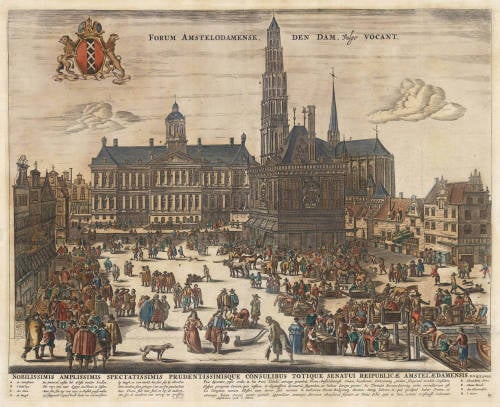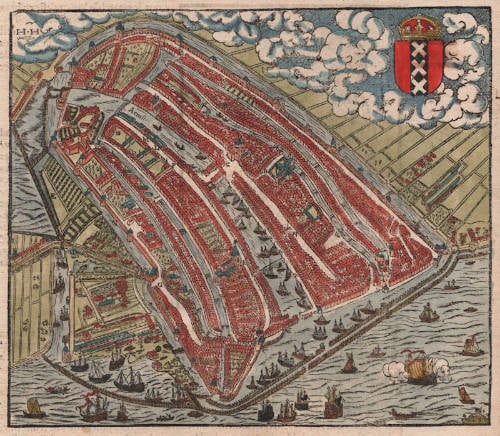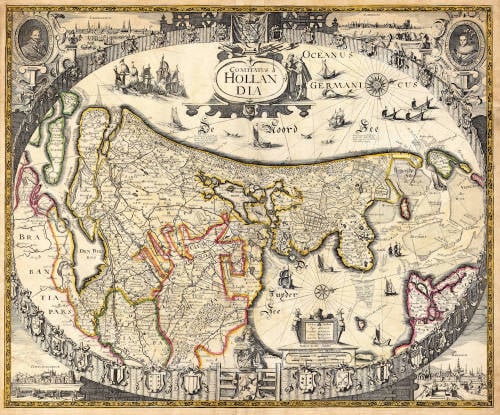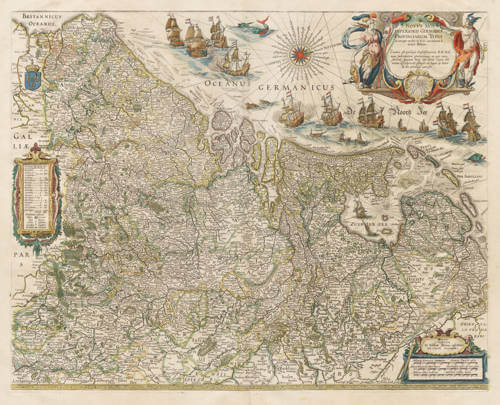Leen Helmink Antique Maps
Antique map of Amsterdam Central Market Square by Frederick de Wit
Stock number: 19321
Zoom ImageCartographer(s)
Frederick de Wit (biography)
Title
FORUM AMSTELODAMENSE, DEN DAM, Vulgo VOCANT.
First Published
Amsterdam, 1655
Size
41.0 x 50.5 cms
Technique
Condition
excellent
Price
$ 7,500.00
(Convert price to other currencies)
Description
Large and spectacular view of Amsterdam market square, of utmost rarity.
Together with the large Visscher panorama of Amsterdam Harbour, this is one of very few large and decorative 17th century views of the city, at the zenith of its power, dominating trade, shipping, art, finances, publishing, architecture, and so on.
Rarity
This view by Frederick de Wit is only known to have survived in one other copy, now in the Amsterdam city archives, from the Atlas Dreesman Collection.
It is an early work by De Wit, of around 1655. It was not included in any regular book or atlas, but sold as a loose broadsheet. At the time, the Dutch did not use wallpaper, but instead they bought loose prints and maps to decorate their walls. From the moment they were mounted and displayed, the maps and prints were doomed, by exposure to the elements: sunlight, humidity, dampness, temperature fluctuations, smoke from pipes, smoke and soot from hearths, varnish, frequent touching, and so on. Made from paper they were also eaten by insects and worms. When darkened and colour-faded and outdated in contents, they were often trashed. The folds on the example offered here suggest that it has survived in a book, protected from the elements and the ravages of time.
Jacob van der Ulft version
The view by the Wit is based on a drawing and print of 1653 by artist Jacob van der Ulft. That print is also of utmost rarity, Rijksmuseum has the van der Ulft example from the illustrious Frits Lugt collection.
Painted version
A cityscape painting in Amsterdam Museum shows the same scene and is believed to be copied after the drawing or print by Jacob van der Ulft.
Condition
No imperfections or restorations. Ample margins all around. Some old vertical and horizontal folds flattened, else excellent. In this example, the impressium by Frederick de Wit at center bottom has been replaced by the impressum of Joshua Ottens, suggesting that the print must have been a commercial success for at least half a century. De Wit's brandname was so popular that Ottens has retained De Wit's name and dedication on the right hand side.
Description
Famous depiction of Amsterdam's central square, The Dam, which has been a significant historical site for the city.
View of Dam Square in Amsterdam. In the background is the new Town Hall, built in 1648-1650 after a design by Jacob van Campen, now Royal Palace Amsterdam. To its right, diagonally behind a row of low houses, is the New Church, including the projected but never completed tower. In the center is the Weigh House, with a number of horses in front of it. The Weigh House was torn down in 1808, when French King Lodewijk Napoleon wanted an unobstructed view from his palace balcony.
The square is lively with walking and talking people, porters, and market women at their stalls. On the right foreground is a part of the Damrak, where workers are busy unloading a barge. Accentuated shadow areas falling to the right due to the evening light coming in from the left. This painting shows the never-built tower of the New Church. It towers high above the town hall. Perhaps the tower was never completed because the city government did not want the new town hall, a symbol of secular power, to be overshadowed by ecclesiastical power.
At the top left is the coat of arms of the city. In the front left is the business of Hendrick Hondius II, 'In den Wackeren Hond', with a dog holding a globe as a logo on the façade. On top of the house are two dogs holding an armillary sphere. The shop had been in the Hondius family since 1621, first by Jodocus Hondius Jr, later by his heirs. The logo and name of the shop are puns on the family name.
The shopname "In den Wackeren Hond" (also sub Cane Vigilanti, in Latin) had been introduced by Jodocus Hondius the Elder and is repeatedly mentioned in publications from the Hondius publishing house. The name of his business sign is a play on words with his surname: de Hondt (modern spelling hond) which is Dutch for 'dog', and his native town in Flanders, Wakken. De wackere Hondt not only means 'the watchful dog', but also 'de Hondt from Wakken'.
Books are on display outside the shop, as was custom at the time.
Frederick de Wit's shop would be in de Calverstraet around the corner (index "A"), as well as the world's first stock exchange, founded in 1611. The shops of Blaeu and Jansson would be around the corner to the right (index "H") "Op 't Water", now named Damrak.
On the Dam, market traders and merchants, with goods on the quay at the front right. Merchant ships in Amsterdam harbour would often offload their cargo on smaller barges that could then bring the goods to the quay of Dam square. In the caption, the dedication and below it, three lines of text in Latin.
Transcriptions and translations of texts appearing on the print
Title:
FORUM AMSTELODAMENSE, DEN DAM, Vulgo VOCANT.
"The Amsterdam Forum, commonly called The Dam."
Dedication:
NOBILISSIMIS AMPLISSIMIS SPECTATISSIMIS PRUDENTISSIMISQUE CONSULIBUS TOTIQUE SENATUI REIPUBLICÆ AMSTELÆDAMENSIS. D.D. H.F. de Widt.
"To the most noble, most distinguished, most respected, and most wise Councillors, and to the entire Senate of the Republic of Amsterdam. Dedication given by H.F. de Widt."
Dutch legend under the print:
Soo ymant wil aenfien het achtste wonder brallen; Die reys niet naer Egypt, om Pharos te besien, Maar slae fyn oog eens neer, in Amstels grijfe wallen, Op 't steijgerend Capitool 't welk blinkt van marmerstien.
Op Waagh, en vrije-markt: hier siet ghij bij elkandren Drie wondren saem gehoopt, 't een om sijn prachticheit. Daer Themis stelt haer stoel, en beij de anderen. Dat sijn de wonderen van nering en profijt.
I. Koverding.
"If anyone wishes to gaze upon the eighth wonder in splendor; There's no need to travel to Egypt, to see the Pharos, But rather let one's eye fall upon, within Amsterdam's ancient walls, The rising Capitol which glistens with marble stone.
At the Weigh House, and the free market: here you will see side by side Three wonders amassed together, one for its magnificence. Where Themis establishes her seat, and among the others. These are the wonders of commerce and profit.
J. Koverding."
Latin legend under the print:
Veni Spectator, pasce oculos in hac brevi Tabella, animoque perambula Forum Amstelodamense, Civium, Incolarum, Exterarumq, gentium frequentia mirabile: Confidera Hospes peregrine Curiam, opus vastum, et elegantissima Symmetria stupendum, an habeat Europa parem! hic Themidis Sacrum, Secretiq, urbis reconditorium est: En Templum novum Illustri cum turre sub nomine S. Catharinae, Pietati Religioniq dicatum: Deniq Libram, in quà quidquid habet Oriens, et utrumque Limen Oceani mittit, quotidie appenditur, tantaque Mercium abondantia stupatur, ut Totius Orbis opes in hanc urbem Confluxisse videantur.
Amstelodami apud I. Ottens.
"Come, Spectator, feast your eyes upon this brief tableau, and with your mind stroll through the Amsterdam Forum, remarkable with the throng of citizens, residents, and foreign nations: Consider, foreign Guest, the Courthouse, a vast work, and a wonder of the most elegant symmetry, whether Europe holds its equal! Here is the sacred place of Themis, and the secret repository of the city: Behold the new Temple with its illustrious tower under the name of St. Catherine, dedicated to Piety and Religion: Finally, the Scale, in which whatever the East holds, and both thresholds of the Ocean send, is weighed daily, and such abundance of goods is marveled at, that the wealth of the Entire World seems to have flowed into this city.
In Amsterdam at [the shop of] J. Ottens."
Frederick de Wit (1629-1706)
Early Life and Beginnings in Amsterdam
Frederick de Wit was born around 1629 in Gouda, a city known for its cultural and intellectual contributions during the Dutch Golden Age. His family was Protestant, and by 1648, 18 or 19 year old De Wit had moved to Amsterdam, a city at the heart of Dutch trade, culture, and mapmaking. Here, he served his apprenticeship under the tutelage of Joan Blaeu, whose family was already famous for producing some of the world's finest atlases and maps.
Establishment in Amsterdam
In 1654, de Wit set up his own printing office and shop, initially named "De Drie Crabben" (The Three Crabs), which was also the name of his residence on Kalverstraat. The following year, he renamed it "De Witte Pascaert" (The White Navigation Chart), signaling his focus on cartography. His early works included a plan of Haarlem in 1648 and illustrations for Antonius Sanderus’s "Flandria Illustrata", but it was his independently engraved map of Denmark in 1659 that marked his entry into the broader mapmaking world.
Cartographic Contributions and Style
De Wit's maps were distinguished by their accuracy, decorative borders, and elaborate cartouches often depicting classical mythology or allegorical scenes. His most famous work, "Nova Totius Terrarum Orbis Tabula," was a world map first published in 1660. The map demonstrated his skill in both geography and artistic design. Over the decades, he produced numerous sea charts, town plans, and wall maps, which were not only navigational aids but also sought after for their beauty and decorative value.
By the 1670s, de Wit was producing larger atlases like the "Atlas Maior" and "Nieuw Kaertboeck van de XVII Nederlandse Provinciën". These atlases combined his own engravings with those he had acquired, showcasing his entrepreneurial spirit. His maps of the Netherlands were particularly notable for their detailed depiction of the Dutch landscape, including cities, waterways, and dykes, reflecting the country's complex relationship with its environment.
Personal Life and Guild Membership
In 1661, de Wit married Maria van der Way, which not only brought him personal happiness but also the privileges of Amsterdam citizenship. This allowed him to join the prestigious Guild of Saint Luke in 1664, which was essential for artists and engravers in the city. His involvement with the guild underscores his standing in the artistic community of Amsterdam.
Later Years and Legacy
De Wit's business thrived, especially after the death of his mentor Blaeu, from which he acquired many copper plates when they were dispersed at auction, positioning him as one of the leading cartographers in Amsterdam. He continued to expand his catalog, ensuring his maps were up-to-date with the latest geographical discoveries. His attention to detail and the aesthetic quality of his work made his maps popular among the elite, scholars, merchants, and navigators alike.
When Frederick de Wit passed away in July 1706, his wife Maria managed the business until 1710. After her death, the vast collection of copper plates was auctioned off, with many going to Pieter Mortier (1661-1711), who used them to further his own publishing empire, Covens & Mortier. In 1721, the copperplates were sold in auction by the heirs of Mortier's widow, and were acquired by the Ottens publishing house in Amsterdam. These transactions illustrate de Wit's lasting influence on the mapmaking industry.
Cultural Impact and Modern Appreciation
De Wit's work encapsulates the spirit of the Dutch Golden Age – a period of unprecedented artistic and scientific achievement. His maps are not merely tools for navigation but are also pieces of art that reflect the cultural pride of the Dutch in their maritime and cartographic prowess. Today, his maps are treasured in collections around the globe, from libraries to smaller, specialized map collections. They are frequently exhibited in museums as exemplars of the Dutch art of cartography, admired for their precision, beauty, and historical significance.
Frederick de Wit's legacy is one of a craftsman whose maps not only charted the physical world but also captured the imagination of those who used them, contributing to the enduring allure of an age when maps were as much about exploration as they were about art.





